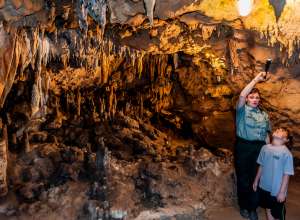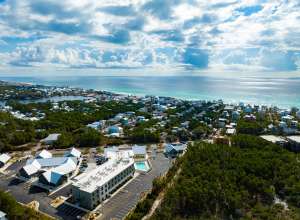Story
South Walton Sea Turtle Season Begins May 1st And Spans The Summer
May 1, 2025 by SoWal Staff

Listen up, beach lovers! It's that special time of year again in South Walton – Sea Turtle Season is officially underway, running from May 1st all the way through October 31st.
These ancient mariners, our flippered friends who've been gracing our shores for millions of years, need our extra TLC during this crucial nesting period.

Think about it – these incredible creatures come ashore to lay their precious eggs, continuing a cycle as old as time. That's where the amazing folks at South Walton Turtle Watch step in. This dedicated group of volunteers are the early birds, hitting our beaches at dawn to locate and protect those fragile nests up and down our beautiful coastline. Remember, it's the law: only certified Turtle Watch members are allowed to get up close and personal with these endangered beauties.
Keep your eyes peeled around the third week of May – that's usually when the first sea turtle nest pops up in Walton County. How do they find them? By looking for tracks that look like giant tractor tires leading from and back to the water's edge. Once a nest is found and the eggs are laid, the watch begins. About 72 hours after the little ones hatch, the nest is carefully excavated. Any stragglers are gently helped on their way to the big blue, and vital info like empty eggshells and nest conditions are reported to the Florida Department of Environmental Protection (DEP).

SoWal Insider Tip: Visit Turtle Bale Spring fountain and sculptures on the south side of Scenic 30A in Alys Beach. It's a thrill for kids and adults and a great place for photos.
The real heroes here are the tireless volunteers of the South Walton Turtle Watch. Rain or shine, they're out there at sunrise, searching for those tell-tale tracks. They document nests, false crawls (when a turtle comes ashore but doesn't nest), and they keep a close eye on hatching nests, recording how many little ones successfully make it to the sea.
And their work doesn't stop at sunrise! Now, dedicated night walkers are also on patrol, keeping an eye out for lighting problems that can disorient hatchlings, sadly leading to many deaths each year.
Want to be a part of this incredible conservation effort? South Walton Turtle Watch needs your help! If you're interested in walking the beach or if you spot a sea turtle or its tracks, give Sharon Maxwell a call at 897-5228, or reach out to the Florida Marine Patrol at 1-800-342-5367.
Here's your chance to make a real difference for our South Walton sea turtles – consider joining the Friends of South Walton Sea Turtles! Let's all do our part to protect these amazing creatures.
Sea turtles, which are among the oldest creatures on earth, have remained essentially unchanged for 110 million years; however, they face an uncertain future. Illegal harvesting, habitat encroachment, and pollution (physical and light) are only some of the things sea turtles must face as each species struggles to stay alive.
“Interfering with a sea turtle hatchling’s trek to the ocean can have fatal consequences,” said FWC sea turtle biologist Dr. Robbin Trindell. “It’s very important to leave them undisturbed. By keeping beaches dark, beachfront buildings dark and giving sea turtles space, we can make sure that our children and grandchildren can also enjoy watching them make this amazing journey.”
FWC helps to protect and conserve marine turtles and their habitat through:
Division of Habitat and Species Conservation - Imperiled Species Management Section (ISM)
Fish and Wildlife Research Institute (FWRI)
Division of Law Enforcement (LE)

Do hatchlings need a full moon to find the ocean after they emerge from their nests?
This is a myth. Hatchlings emerge from their nests at all phases of the moon and successfully find the ocean.
How do hatchlings know the direction of the ocean when they emerge from their nests?
Sea turtles are born with the instinct to move toward the brightest direction. On a natural beach, this direction is the light of the open horizon.
How long do sea turtles live?
Sea turtles can live 40 to 60 years or more.
How long does it take before the eggs hatch?
Sea turtle eggs have an incubation period of about two months.
How many nests are laid in Florida?
Along the Florida coast, sea turtles annually make between 40,000 and 84,000 nests.
How many nests does each female sea turtle lay?
Females nest every two to three years, laying several nests on sandy beaches. After digging a hole and depositing about 80-120 eggs, the females fill in the hole with sand and camouflage the nest before returning to the sea.
How many species of sea turtles are listed as endangered or threatened?
All five Florida species are listed as either endangered or threatened. The federal Endangered Species Act lists the green, leatherback, hawksbill, and Kemp's ridley turtle as endangered. The loggerhead is listed as threatened. This makes it illegal to harm, harass, or kill any sea turtles, their eggs, or hatchlings. It is also illegal to import, sell, or transport turtles or their products.
How many species of sea turtles are there in Florida?
Five species of sea turtles can be found in Florida:
- Hawksbill Turtle
- Kemp's ridley
- Loggerhead Turtle
- Leatherback Turtle
- Green Turtle
How much do sea turtles weigh?
Sea turtles range in size from the 75-100 pound Kemp's ridley to the 1,300 pound, 8-foot-long leatherback.
What can I do to help protect Florida's sea turtles?
- Organize or join a beach clean up day. Check with organizations or schools in your area to become involved in clearing the beaches of trash that could be harmful to wildlife.
- Do not leave fishing line behind. This entangles many types of wildlife including sea turtles.
- Do not feed sea turtles or other wildlife. This encourages them to approach people in high traffic areas.
- Never buy products made from sea turtles.
- Reduce the amount of plastic garbage you produce.
- Turn off the lights! Keep beachfront lights off throughout the night from May to October as they can confuse sea turtles during the mating season. Suggested alternatives to decrease artificial lighting include use of motion sensors for safety, dark window tinting and curtains to cover inside light, and yellow incandescent light bulbs ("bug lights"). Studies have also shown that light from low pressure sodium vapor sources don't attract turtles as much as high pressure sodium lights Avoid fluorescent, mercury vapor, metal halide, and white incandescent lighting.
- Oppose coastal armoring. The fewer obstacles sea turtles have to overcome, the better their chances of successful nesting.
- Reduce the amount of fertilizers you use. Ordinary lawn and garden fertilizers wash into coastal waters killing plants and animals. Look for biodegradable alternatives, and correctly dispose of used toxic chemicals.
- Write a letter to the editor. Use your local newspaper to inform people about the plight of sea turtles and what they can do to help.
- Adopt a Turtle. Join and support the Sea Turtle Survival League by calling 1-800-678-7853 or writing to 4424 N.W. 13th St. Suite A-1, Gainesville, FL 32609.
- Buy a License Plate. The next time you renew your automobile registration at your local tax collector's office, request a specialty sea turtle plate. The extra dollars go toward protection, research, and recovery programs at the Marine Resources Conservation Trust Fund in the Florida Fish and Wildlife Conservation Commission.
What do the hatchlings do after they leave their nests?
After the two-month incubation period, the turtle hatchlings all dig out of their nest at the same time, a process that can take several days. As a group, they then leave their nest at night and head directly for the sea. This first trek "imprints" their home beach into the hatchlings. Once grown, the turtles will return to lay their nests on the same beach.
What is a hatchling's chance of survival?
Only about one in 1,000 turtles survive to adulthood. Hatchlings die of dehydration if they don't make it to the ocean fast enough. Birds, crabs, and other animals also prey on the young turtles.
What should I do if I find hatchlings wandering in a road, parking lot, or in directions other than toward the water?
Call the Florida Fish and Wildlife Conservation Commission (FWC) Division of Law Enforcement at 1-888-404-FWCC or *FWC from your cell phone.
What should I do if I find sea turtle hatchlings on the beach?
- Watch from a distance.
- Allow them to crawl to the water on their own.
- Leave them in their nest.
- Keep all lights off.
What should I do if I see a sea turtle nesting?
- Stay behind her at a distance and remain quiet.
- Don't use any lights, including flashlights, flash photography, and video equipment.
- Don't put your hands on or near the turtle. Any distractions may frighten and disorient her, causing her to return to the ocean before completely covering and camouflaging her nest.
What threatens sea turtle survival?
- Natural Predation-Many predators such as crabs, ants, raccoons, and birds target turtle eggs and hatchlings. If they are lucky enough to reach adulthood, sea turtles are relatively immune to predation, except for the occasional shark attack.
- Human Predation-Though most countries have laws against harvesting sea turtle eggs for food, the laws are not well enforced. Adult turtles are also harvested for meat, and their shells are made into jewelry and souvenirs.
- Commercial Fishing-Entanglement in fishing nets is a major contributor to the death toll of juvenile and adult sea turtles. In the past, shrimping nets killed more than 50,000 turtles annually. Now, U.S. shrimpers are required to put Turtle Excluder Devices (TEDs) on their trawl nets.
- Ingesting Plastic and other litter and debris-Thousands of sea turtles die each year from eating and becoming entangled in plastic bags and balloons floating in the water. While releasing helium balloons into the air is a common way to celebrate and event, the balloons end up drifting in the oceans where sea turtles mistake them for one of their main food sources, jellyfish.
- Artificial Lighting-Nesting sea turtles look for dark, quiet beaches to lay their eggs. Lights from buildings along the beach distract and confuse the females as well as the hatchlings. When the young turtles emerge from the nest at night, they are drawn toward the lights instead of the water. A single light can cause hundreds of misdirected hatchlings to be killed by automobiles on nearby roads and parking lots, dehydrate in the morning sun, and increase their chance of being killed by predators like birds, crabs, and even cats.
- Coastal Armoring-Sea walls, sandbags, and other barriers built to protect beachfront property from erosion block female turtles from ideal nesting grounds. The developing coastline is rapidly encroaching on suitable nesting beaches.
- Beach Nourishment-Another way to combat property erosion on beaches is to bring in truckloads of sand. If the sand is of a different consistency or is too compacted, the nesting behaviors of turtles can be drastically altered. If the renourishment is done during nesting season, there is also a possibility nests will be buried too far underground or be run over by trucks.
- Pollution-Everything from oil spills to fertilizer runoff can contaminate the ocean habitat of the sea turtles, killing their food sources and causing terminal diseases.
When do sea turtles nest?
The main nesting months run from May to October, but there are many exceptions to the rule. Leatherbacks have been known to start as early as February, and depending on water temperature, hatchlings emerge well into the winter months.
Who should I call if I find a stranded turtle?
Call the Florida Fish and Wildlife Conservation Commission (FWC) Division of Law Enforcement at 1-888-404-FWCC or *FWC from your cell phone.















